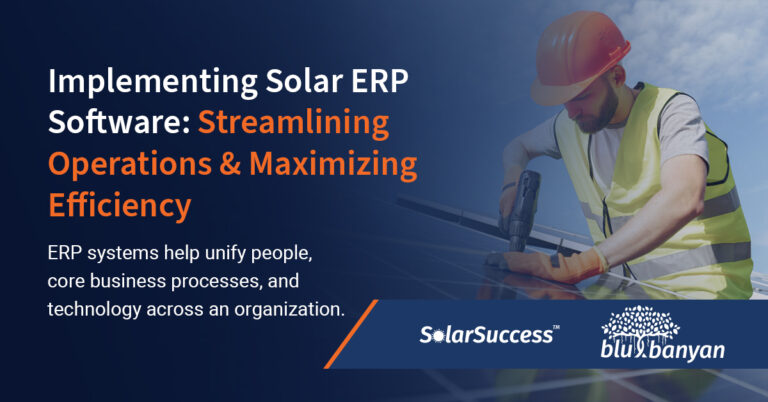As environmental concerns increase and energy prices soar worldwide, solar energy is rapidly becoming a popular choice for organizations seeking sustainable and cost-effective power solutions. As the solar industry continues to grow, it becomes increasingly important for solar companies to optimize their operations and manage their resources effectively. This is where implementing a solar-specific Enterprise Resource Planning (ERP) software solution can play a crucial role.
What is an ERP?
ERP is an application that automates business processes and provides insights and internal controls to run all day-to day business. It draws on a central database (single source of truth) that collects inputs from various departments, including accounting, project management, inventory management, field services management, sales/CRM, all sitting on a single platform.
An ERP system empowers business to analyze various scenarios, discover process improvements and generate major efficiency gains. That translates to cost savings and better productivity as people spend less time digging for needed data.
Put simply, an ERP system helps unify people, core business processes and technology across an organization.
Why Use a Solar-Specific ERP?
When considering ERP software options, it’s essential to understand the difference between a solar-specific ERP solution and an industry-agnostic one. While industry-agnostic ERP systems can be customized to suit various sectors, solar-specific ERP software is designed specifically to meet the unique needs of solar energy companies. It incorporates industry-specific modules, such as solar project management, equipment tracking, and energy production monitoring, providing specialized features and functionalities that can streamline solar-specific workflows.
Now that we know the difference between a solar-specific and an industry-agnostic ERP solution, how can you start with the implementation of this ERP solution in your business? Let’s look at the key considerations and steps involved in implementing solar ERP software, which are important to ensure a seamless transition and long-term success.
Defining Goals and Objectives
Before implementing any software solution, it’s vital to define clear goals and objectives. What specific outcomes do you want to achieve with your solar ERP software implementation? For example, you might aim to improve project management efficiency, optimize resource allocation, enhance cash management excellence and cost control, or strengthen compliance with regulatory standards. Clearly outlining your goals will help guide your selection process and set realistic expectations.
Choosing the Right Software
The specific goals you want to achieve will then guide your selection of the appropriate solar ERP software. Conduct thorough research, evaluate different vendors, and consider factors such as functionality, scalability, ease of use, integration capabilities, and vendor reputation. The software you choose should align with your defined goals and objectives while also accommodating future growth and evolving industry requirements.
Involving Key Stakeholders
To ensure a successful implementation, involve key stakeholders from across your organization. This starts with engaging representatives from various departments, including project management, finance, operations, and IT. Seek their input, understand their specific needs, and address any concerns they may have. Involving stakeholders early on promotes collaboration, and also helps ensure that the ERP software will be able to meet the diverse requirements of your organization.
Obtaining Company-Wide Support
Securing company-wide support comes hand-in-hand with involving key stakeholders. From top-level management to front-line employees, communicate the benefits of the solar ERP software and how it aligns with the organization’s overall strategy. By emphasizing the positive impact the software will have on productivity, efficiency, and profitability, your company is more likely to accept this change.
Developing a Comprehensive Implementation Plan
A well-defined implementation plan is the backbone of a successful ERP software deployment. This plan should include a detailed roadmap that outlines key milestones, timelines, resource allocation, and dependencies. To mitigate risks and ensure a gradual and controlled transition, you can break the implementation process into manageable phases. Assigning responsibilities and establishing clear communication channels can facilitate collaboration and allow progress to be tracked effectively.
Providing Adequate Training
Any major change can be tough to manage, but providing training can ensure a smooth transition. Comprehensive training sessions should cover all relevant modules and functionalities to empower your employees to utilize the new solar ERP software effectively. Offer both initial training for the implementation phase and ongoing training to support continuous learning and skill development. Providing your team with resources such as user manuals, video tutorials, and online support can also reinforce training efforts and encourage self-guided learning.
Test and Validating the System
To ensure the system works well, you must thoroughly test and validate the solar ERP software before going live. Conduct extensive testing across different scenarios and workflows to identify and rectify any potential issues or bugs. The key stakeholders, who will be the end-users, should also be involved in the testing process to gather feedback and ensure the software meets their specific needs. The system should also be validated against your defined goals and objectives, ensuring that it delivers the expected outcomes.
Monitoring and Measuring Performance
Once the solar ERP software is up and running, continuously monitor and measure its performance. Key performance indicators (KPIs) can be established to assess the software’s impact on project timelines, resource utilization, cost control, and overall operational efficiency. Remember to regularly review and analyze the data to identify areas for improvement and take proactive measures to address any issues or bottlenecks.
Ensuring Ongoing Maintenance and Support
Lastly, now that the software is up and running, it is also crucial to keep up with maintenance and support for long-term success. You can either set up an in-house support team or engage with the software vendor for ongoing technical assistance, software updates, and bug fixes. Regularly review and optimize the software configuration to accommodate evolving business requirements and industry trends.
Blu Banyan is Here to Help
By following these steps and considerations, implementing solar ERP software successfully has never been easier. With the right software solution in place, your organization can streamline operations, maximize efficiency, and capitalize on the growing opportunities in the solar energy industry.
Looking to embrace the power of solar ERP software? Here at Blu Banyan, we can help implement your solar ERP software to increase the productivity and efficiency of your business.




